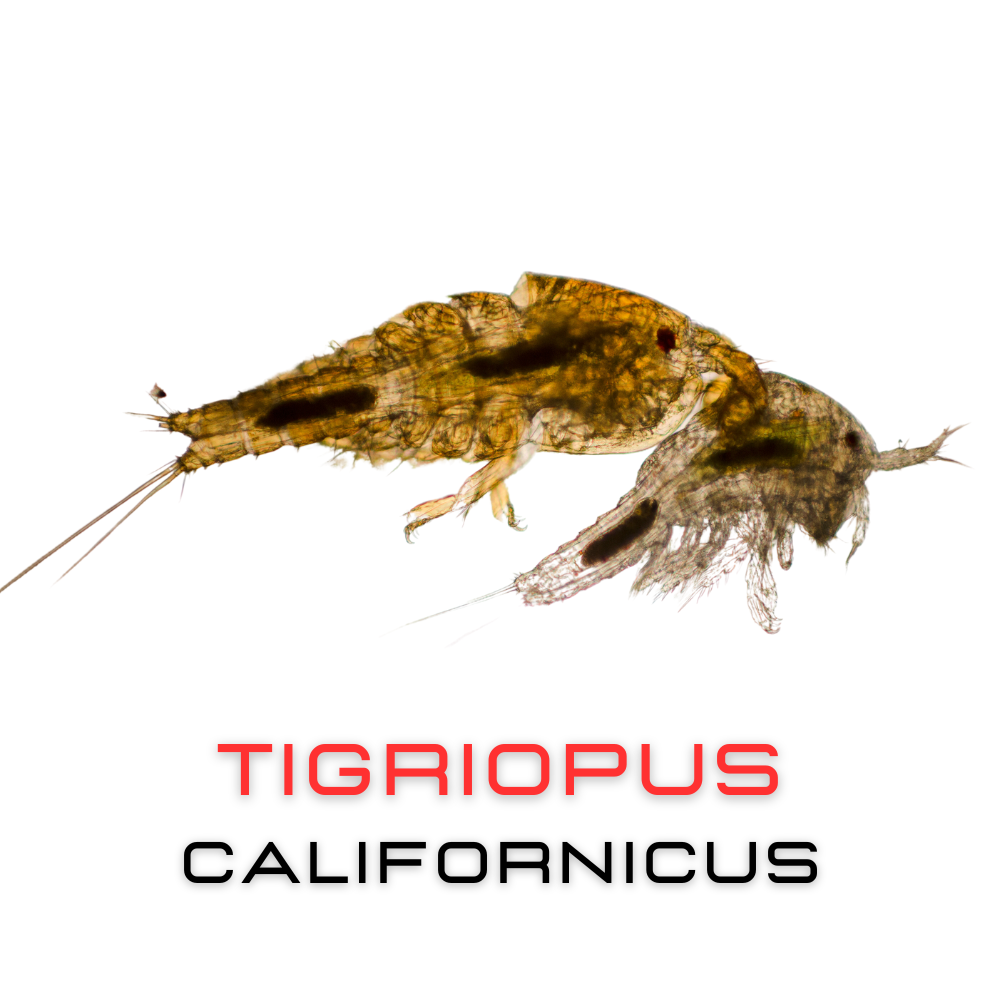Your cart is currently empty!

WHAT ARE TIGRIOPUS COPEPODS?
Copepods are very small, insect-like animals that are essential to the marine ecosystem.
Tigriopus californicus, also known as “tig pods”, are well-known copepods found in large
numbers within supralittoral pools along the west coast. These copepods are only 2mm in length
but make up 70% of the ocean’s biomass. T. californicus is a type of marine organism called
meiofauna. Meiofauna are small animals that live in the sediments of the ocean floor, meaning
that these copepods spend most of their time looking for food within the sediment. Overall, these
tiny crustaceans are known for their ability to adapt to extreme environmental conditions, serve
as a food source, and reproduce rapidly.
ENVIRONMENT
Tigriopus californicus are well adapted to a wide range of environmental conditions.
They can be found in supralittoral zones along the west coast from California all the way to
Alaska. Unlike intertidal zones, these supralittoral pools come from high-tides or storms and get
splashed by water regularly, but not submerged. With these pools, comes variable conditions due
to water evaporation. Although these copepods are forced to deal with constantly changing
environments, normal feeding and reproduction is found at salinities up to 75.3 ppt and at
temperatures from 10°C (50°F) to 40°C (104°F).
In your reef tank, T. californicus will be feeding on plant matter because they are
herbivorous animals. They mainly feed on algae and bacteria, while they may still ingest detritus,
macroalgae, and other copepods by accident. In order to feed, they must use their thoracopods,
which are feeding appendages that help them to filter out their food from the water. In your reef
tank, while T. californicus is feeding on your excess algae, it can also be used as live feed for
your other marine organisms, providing them with nutritious omega-3 fatty acids.
REPRODUCTION
Given favorable environmental conditions, Tigriopus californicus will reproduce very
often. During reproduction, male T. californicus will clasp to females in order to create mating
pairs. If fertilization occurs before the terminal moult, non-viable eggs are produced. This means
that the females must reach maturity first before being fertilized. Female T. californicus only
mate once, whereas males can inseminate about 3 females ever 72 hours. One single
insemination could produce up to 300 offspring!
The life cycle of Tigriopus californicus is more complex than one might expect. It
consists of 6 naupliar stages and 6 copepodid stages, where the last copepodid stage is the adult
stage. In the naupliar stage, copepods hatch from fertilized eggs into a larval stage. Here, the
copepod is the most vulnerable and experience higher rates of mortality due to predation and
starvation. In the copepodid stage, the organism becomes much more morphologically similar to
copepod adults. Once the copepods are adults, they can live for several months depending on
environmental conditions.
While they are small animals, Tigriopus californicus is a species of copepod that will
play a vital role in keeping your reef tank ecosystem healthy. With these copepods, a reef tank
will be free of nuisance algae, organisms will be fed by eating nutritious Tigriopus californicus, and this source of food will continue to reproduce. Tigriopus californicus will be a valuable
addition to any reef tank.
REFERENCES
O’Brien, P., Feldman, H., Grill, E. V., & Lewis, A. G. (1988). Copper tolerance of the life history
stages of the splashpool copepod Tigriopus californicus (Copepoda, Harpacticoida). Mar.
Ecol. Prog. Ser, 44(5).
Powlik, J. J., Lewis, A. G., & Spaeth, M. (1997). Development, Body Length, and Feeding of
Tigriopus californicus (Copepoda, Harpacticoida) in Laboratory and Field Populations.
Crustaceana, 70(3), 324–343. http://www.jstor.org/stable/20105864
Prado-Cabrero, A., Herena-Garcia, R., & Nolan, J. M. (2022). Intensive production of the
harpacticoid copepod Tigriopus californicus in a zero-effluent ‘green water’bioreactor.
Scientific Reports, 12(1), 466.
Suárez-Morales, E. (2015). Class maxillopoda. In Thorp and Covich’s Freshwater Invertebrates
(pp. 709-755). Academic Press.
Wiktorowicz-Conroy, A. L. E. X. I. S. (2019). The Biology of Splashpool Copepods (Tigriopus
californicus). Algae Research and Supply.


